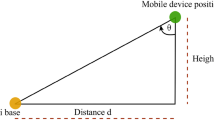Abstract
Recent improvements in the capabilities of smart phones are making the location-based augmented reality services a reality. When widely used, such a system is expected to produce many user-created geospatial tags concentrated at popular and important sites. In this paper, we describe a way to organize and group such geospatial tags (manually or automatically using a nearest neighbor algorithm) and how to efficiently interact to search and find the tag that the user might be interested in. The proposed method was implemented on an Apple iPhone, and an experiment was carried out to verify the improved usability. The results do indicate the advantage of the principle of hierarchical organization of data. We also further found that the “automatic-but-less-accurate” approach is more suitable than “precise-but-manual” due to the dynamic nature of the mobile interaction and less than perfect sensing.








Similar content being viewed by others
References
Cable News Network (2009) New phone apps seek to augment reality
Tonchidot Corporation (2009) Sekai camera tagging the world. http://sekaicamera.com/
Mobilizy (2009) WIKITUDE world browser. http://www.wikitude.org/
Layar (2009) Layar browse the world!, http://layar.com/
Hastie T, Tibshirani R, Friedman J (2006) The elements of statistical learning: data mining, inference and prediction. Springer, London
Cover TM, Hart P (1967) Nearest neighbor pattern classification. IEEE Trans Inf Theory 13(1):21–27
Google (2009) Google Earth. http://earth.google.com
Microsoft (2009) Virtual Earth. http://www.microsoft.com/maps
Ware C (2000) Information visualization: perception for design. Morgan Kaufmann Publishers, San Francisco
Shneiderman B (1997) Designing the user interface: strategies for effective human-computer interaction. Pearson/Addison-Wesley, New Jersey
Acknowledgments
This research was supported by the Ministry of Knowledge Economy and KIAT through the Strategic Technology Laboratory program.
Author information
Authors and Affiliations
Corresponding author
Rights and permissions
About this article
Cite this article
Choi, J., Jang, B. & Kim, G.J. Organizing and presenting geospatial tags in location-based augmented reality. Pers Ubiquit Comput 15, 641–647 (2011). https://doi.org/10.1007/s00779-010-0343-3
Received:
Accepted:
Published:
Issue Date:
DOI: https://doi.org/10.1007/s00779-010-0343-3




